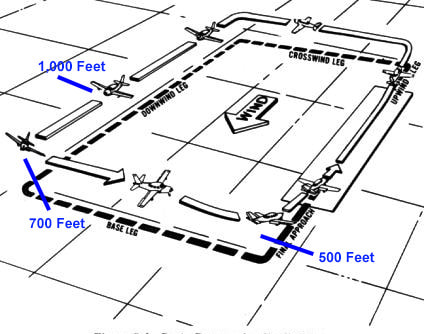|
One thing that might be of tremendous help when working to perfect your traffic pattern is selecting certain altitudes for key points in the traffic pattern. This gives a measurable aiming point and will help assure a more stabilized approach. It should be noted that these are just general guidelines that help in a standard situation. An airport with a non-standard traffic pattern, or a traffic pattern requiring extended or shortened pattern legs may require a different approach (literally!). The AIM says that unless otherwise stated for a particular airport, 1,000 feet AGL shall be used as the standard traffic pattern altitude. During a standard downwind in a small single-engine piston airplane, the pilot should maintain this 1,000 feet AGL until abeam the touch down point or runway numbers. The pilot should plan their descent so that they arrive at about 700 feet AGL when they make their downwind to base turn. They should continue their descent to arrive at 500 feet AGL when turning base to final. This 500 feet AGL should provide a safe altitude from which the pilot can judge if they are too low or two high (the result of improper altitude control or too wide/too tight a base leg). Remember, a good landing begins in the traffic pattern. Practice your landings and aim for consistency each time.
1 Comment
|
|
- Home
-
Flight Instruction
- Private Pilot Flight Training
- Remote Pilot Part 107 Drone UAS Training
- Sport Pilot Flight Training
- Instrument Rating Flight Training
- Commercial Pilot Flight Training
- Multi-Engine Flight Training
- CFI Flight Training
- ATP Flight Training
- Bend Flight Training
- Flight Simulators
- Flight Review
- Paragliding and Paramotoring
- Private Pilot Ground School
-
Courses & Books
- Learning Center
- Contact
- Pilot Resources
- Our Goal
- News
- Ferry Pilot Services
- Contract Pilot Services
- Oregon Flight Instructor Jobs

